The Union have quickly become the team in MLS that other teams should emulate. They've got the second best expected goal difference (xGD) per game. Though, in fairness,, the gap between them and LAFC in first is the same as the gap between them and the Columbus Crew, who currently sit 17th in MLS. But, in further fairness,their budget isn't in the same stratosphere as LAFC, to say nothing of the teams they rank above likeAtlanta, Toronto, NYCFC, and the LA Galaxy. It's easy to look at the success Atlanta and LAFC have had and say that if teams would just spend money they'd be better (and owners should spend more money), but in MLS, in large part because of the restrictive salary cap, teams can be competitive on a smaller budget if they prioritize youth development, make intelligent tactical choices, and recruit with the needs of their system in mind. It would be incorrect to characterize the Union as the surprise of the season. The Earthquakes have gone from the worst team in MLS to a top 5 team, and LAFC is having arguably the best MLS season ever, but the Union were not supposed to be on top of the Eastern Conference two thirds of the way through the season. They entered the year with a new Sporting Director, Ernst Tanner; a lame-duck coach, Jim Curtin; and middling expectations. Tanner was brought in to replace Earnie Stewart, who became the General Manager of the United States Men’s National Team following their failure to qualify for the World Cup. Previously the academy director at Red Bull Salzburg, Tanner, had received plaudits as the man responsible for bringing Roberto Firmino to Hoffenheim and Naby Keita to Salzburg. Under Earnie Stewart, the Union had a reputation of being a possession team. With Tanner’s arrival the expectation was that the Union would start high-pressing more and valuing possession less, a philosophy very similar to what current Red Bull Salzburg manager, Jesse Marsch, adhered to while he was at the New York Red Bulls. The Union are absolutely high pressing more; their passes per defensive action have dropped from 11.15 last year to 8.78 this year, fifth best in the league. 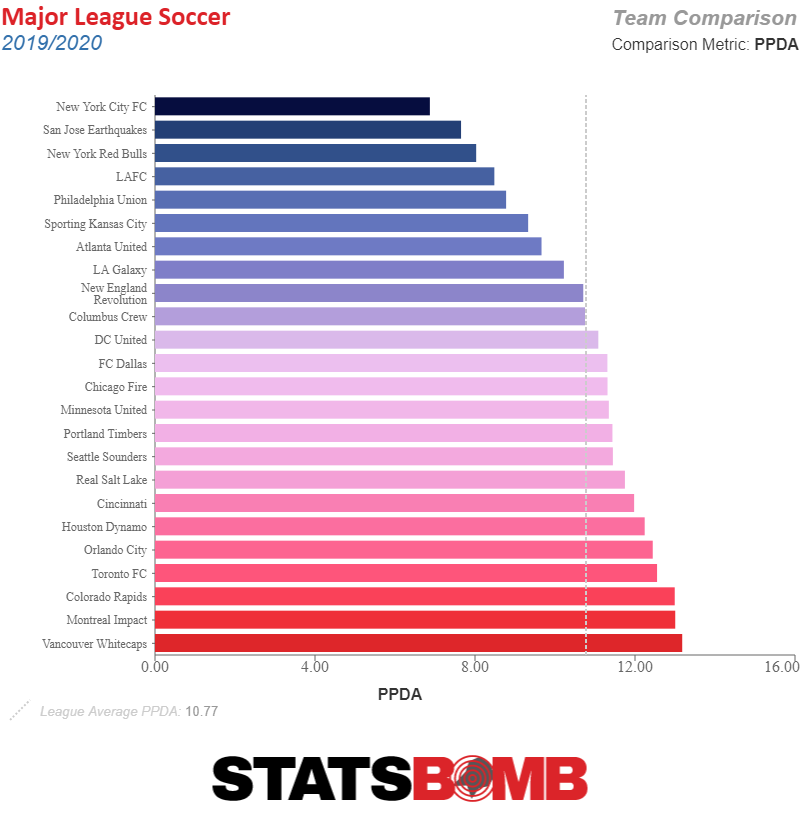 Interestingly, the increase in pressing hasn’t made the team particularly susceptible at the back. It speaks very well of Philadelphia’s implementation that despite being more aggressive, the team is currently second in MLS at limiting clear shots by their opponent.
Interestingly, the increase in pressing hasn’t made the team particularly susceptible at the back. It speaks very well of Philadelphia’s implementation that despite being more aggressive, the team is currently second in MLS at limiting clear shots by their opponent. 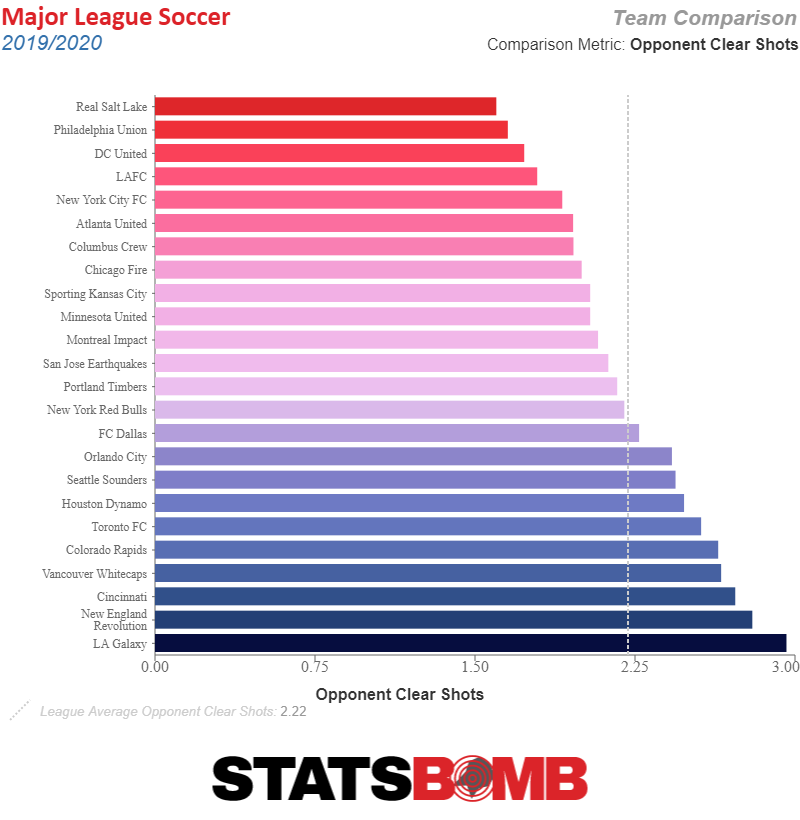 With the ball, the team has remained one of the most patient teams in MLS. The speculation that they would value possession less under Tanner hasn’t come to fruition on the field. The team is actually possessing the ball more (53% this year, 50% last year). The press has increased the amount of transition opportunities, and the Union have taken advantage of that. They’re taking 12% more shots counter attacking or high press situations than they did last year, but they’ve also shown an ability to win the ball back, enjoying sustained periods of possession. The changes haven’t just been tactical. While Stewart was the GM and for the entirety of Curtin’s tenure, the Union generally lined up in a 4-2-3-1 or 4-3-3 formation. This year the team has almost exclusively lined up in a narrow 4-4-2 diamond. While much of the credit will go to Tanner for bringing a style of play that the Union have obviously benefited from, Curtin deserves praise as well for being open to the change and implementing it effectively on the field. Off the field, the Union were one of the earliest teams to prioritize youth development. In 2013 the Union created a private high school, YSC Academy, for their academy players to attend. Due to MLS’ Byzantine rules for recruiting academy players (Each team has an exclusive area where only they can sign players to homegrown contracts, but large swaths of the country don’t fall into any team’s exclusive area), the school has provided a large competitive advantage, recruiting players who live in talent-rich areas that don’t fall in an existing MLS team’s exclusive territory. The Union have used their residency program and YSC Academy to attract talented players from all over the country to Philadelphia. Recent rumors suggest that MLS might do away with the homegrown territories rule and allow teams to freely recruit within the country. The Union are well positioned to be one of the teams to benefit from that rule change given the infrastructure they’ve already established and their willingness to put academy graduates on the field. This season 16% of the Union’s available minutes have gone to players on homegrown contracts. Additionally, they’re in the top 3 in the league in terms of the number of academy graduates that have seen the field and total minutes played by homegrowns. While a number of academy graduates have seen the field, only two have become regular starters for the team: Brenden Aaronson and Auston Trusty. Trusty, alongside fellow academy graduate Mark McKenzie, became a regular starter at center back last season. This season Trusty has primarily played next to Jack Elliot but regardless of his partner, he’s been the more active defender in the pairing. He’s not particularly strong in the air, but he reads the game well and is athletic enough to act on what he sees.
With the ball, the team has remained one of the most patient teams in MLS. The speculation that they would value possession less under Tanner hasn’t come to fruition on the field. The team is actually possessing the ball more (53% this year, 50% last year). The press has increased the amount of transition opportunities, and the Union have taken advantage of that. They’re taking 12% more shots counter attacking or high press situations than they did last year, but they’ve also shown an ability to win the ball back, enjoying sustained periods of possession. The changes haven’t just been tactical. While Stewart was the GM and for the entirety of Curtin’s tenure, the Union generally lined up in a 4-2-3-1 or 4-3-3 formation. This year the team has almost exclusively lined up in a narrow 4-4-2 diamond. While much of the credit will go to Tanner for bringing a style of play that the Union have obviously benefited from, Curtin deserves praise as well for being open to the change and implementing it effectively on the field. Off the field, the Union were one of the earliest teams to prioritize youth development. In 2013 the Union created a private high school, YSC Academy, for their academy players to attend. Due to MLS’ Byzantine rules for recruiting academy players (Each team has an exclusive area where only they can sign players to homegrown contracts, but large swaths of the country don’t fall into any team’s exclusive area), the school has provided a large competitive advantage, recruiting players who live in talent-rich areas that don’t fall in an existing MLS team’s exclusive territory. The Union have used their residency program and YSC Academy to attract talented players from all over the country to Philadelphia. Recent rumors suggest that MLS might do away with the homegrown territories rule and allow teams to freely recruit within the country. The Union are well positioned to be one of the teams to benefit from that rule change given the infrastructure they’ve already established and their willingness to put academy graduates on the field. This season 16% of the Union’s available minutes have gone to players on homegrown contracts. Additionally, they’re in the top 3 in the league in terms of the number of academy graduates that have seen the field and total minutes played by homegrowns. While a number of academy graduates have seen the field, only two have become regular starters for the team: Brenden Aaronson and Auston Trusty. Trusty, alongside fellow academy graduate Mark McKenzie, became a regular starter at center back last season. This season Trusty has primarily played next to Jack Elliot but regardless of his partner, he’s been the more active defender in the pairing. He’s not particularly strong in the air, but he reads the game well and is athletic enough to act on what he sees. 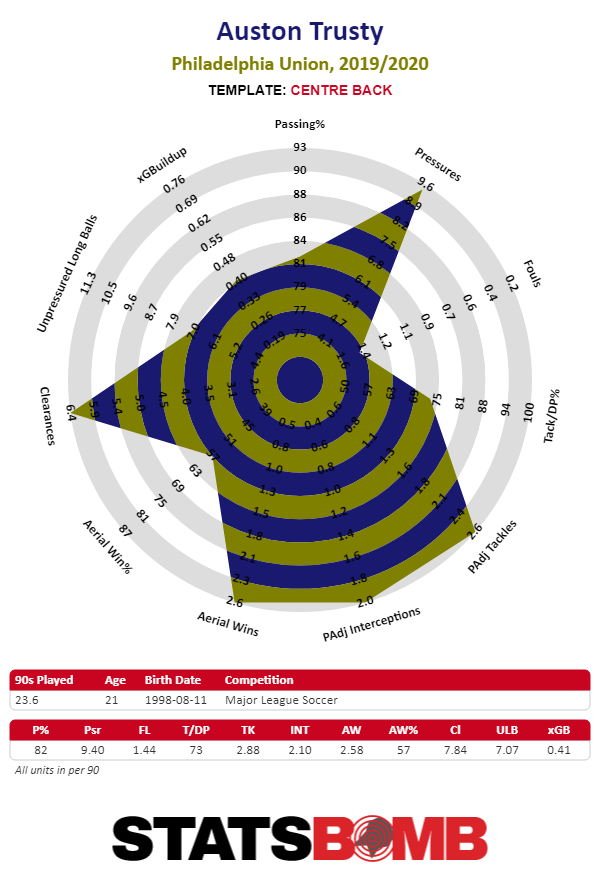 Aaronson, who saw time early in the season because Marco Fabian was injured, hasn’t given up his place in the starting lineup. Initially, he primarily played at the tip of the diamond, but Curtin has preferred a healthy Marco Fabian or Jamiro Monteiro at that spot in recent months. Consequently, Aaronson has been utilized as a shuttler opposite either Monteiro or Alejandro Bedoya. Due in part to this deeper role, he hasn’t been a notable goal threat, but he’s done a lot of defensive work and shown some promise as a dribbler.
Aaronson, who saw time early in the season because Marco Fabian was injured, hasn’t given up his place in the starting lineup. Initially, he primarily played at the tip of the diamond, but Curtin has preferred a healthy Marco Fabian or Jamiro Monteiro at that spot in recent months. Consequently, Aaronson has been utilized as a shuttler opposite either Monteiro or Alejandro Bedoya. Due in part to this deeper role, he hasn’t been a notable goal threat, but he’s done a lot of defensive work and shown some promise as a dribbler. 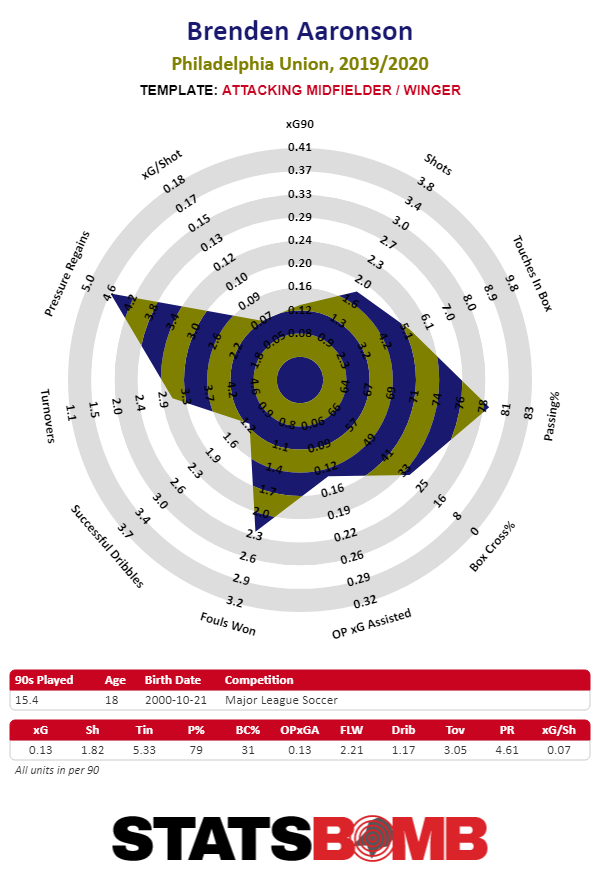 While the academy is starting to bear fruit, Union fans have long clamored for the team to make more noise in the transfer market. It would be easy to point to the signing of Fabian as a statement of intent that set the tone for the season, but between injury problems and an early season red card suspension, Fabian has played only a third of the available minutes. While the Fabian signing has not yet met expectations, Tanner has brought some flair to the Union’s recruitment that was previously lacking. He’s brought in players from second and third division in Germany, a striker from the Chilean league, and a midfielder from Ligue 1. Every player has been at least a spot starter, and none of them have performed significantly below expectations when on the field. The least heralded player Tanner brought in has been the most important. Kai Wagner, purchased from the Wurzburger Kickers in the 3.Liga, has been one of the best left backs in MLS. The Union’s system is a great example of how much responsibility can be put on the fullback in the modern game. Not only is Wagner responsible for tracking the opposing teams right winger, but he is also typically the only player providing width on the left when the Union are in possession. He’s excelled on the defensive side of the ball, and hasn’t been a liability in possession. Wagner is the kind of low risk-high upside acquisition that budget conscientious MLS teams should make more often. There is no threat of looming relegation; they can take risks and generally avoid serious consequences.
While the academy is starting to bear fruit, Union fans have long clamored for the team to make more noise in the transfer market. It would be easy to point to the signing of Fabian as a statement of intent that set the tone for the season, but between injury problems and an early season red card suspension, Fabian has played only a third of the available minutes. While the Fabian signing has not yet met expectations, Tanner has brought some flair to the Union’s recruitment that was previously lacking. He’s brought in players from second and third division in Germany, a striker from the Chilean league, and a midfielder from Ligue 1. Every player has been at least a spot starter, and none of them have performed significantly below expectations when on the field. The least heralded player Tanner brought in has been the most important. Kai Wagner, purchased from the Wurzburger Kickers in the 3.Liga, has been one of the best left backs in MLS. The Union’s system is a great example of how much responsibility can be put on the fullback in the modern game. Not only is Wagner responsible for tracking the opposing teams right winger, but he is also typically the only player providing width on the left when the Union are in possession. He’s excelled on the defensive side of the ball, and hasn’t been a liability in possession. Wagner is the kind of low risk-high upside acquisition that budget conscientious MLS teams should make more often. There is no threat of looming relegation; they can take risks and generally avoid serious consequences. 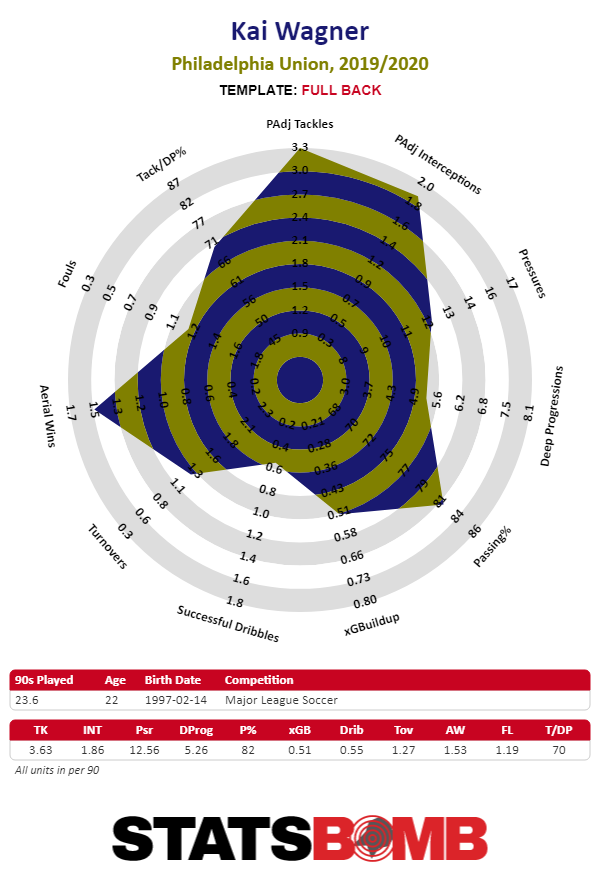 What they can’t do is try to compete with the bigger spenders on a level playing field. The Union have exceeded expectations by investing in areas of the team that are generally neglected by other MLS clubs. The problem Philadelphia will eventually face is similar to the one that Oakland A’s faced once the Yankees and Red Sox started pouring money into analytics. The competitive advantages small market teams find go away in a hurry once richer clubs start valuing them. LAFC is already implementing a similar model with a much larger budget, and because success breeds imitation other clubs are sure to follow. That inevitable shift will be great for the league, but likely bad for the Union. Their window is now, before everybody else figures out exactly how they’re winning.
What they can’t do is try to compete with the bigger spenders on a level playing field. The Union have exceeded expectations by investing in areas of the team that are generally neglected by other MLS clubs. The problem Philadelphia will eventually face is similar to the one that Oakland A’s faced once the Yankees and Red Sox started pouring money into analytics. The competitive advantages small market teams find go away in a hurry once richer clubs start valuing them. LAFC is already implementing a similar model with a much larger budget, and because success breeds imitation other clubs are sure to follow. That inevitable shift will be great for the league, but likely bad for the Union. Their window is now, before everybody else figures out exactly how they’re winning.
2019
The unlikely MLS success story of the Philadelphia Union
By admin
|
August 16, 2019